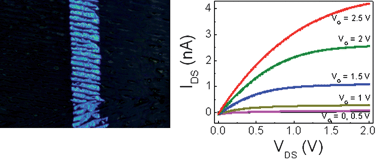Periodic arrays of organic crystals on polymer gate dielectric for low-voltage field-effect transistors and complementary inverter
Abstract
Periodic arrays of highly oriented

* Corresponding authors
a
Department of Chemistry, Konkuk University, Seoul, Republic of Korea
E-mail:
pyosm@konkuk.ac.kr
Fax: (+82) 2 3436 5382
Tel: (+82) 2 450 3397
b Pohang Accelerator Laboratory, Pohang, Republic of Korea
Periodic arrays of highly oriented

 Please wait while we load your content...
Something went wrong. Try again?
Please wait while we load your content...
Something went wrong. Try again?
B. Mukherjee, T. J. Shin, K. Sim, M. Mukherjee, J. Lee, S. H. Kim and S. Pyo, J. Mater. Chem., 2010, 20, 9047 DOI: 10.1039/C0JM01220C
To request permission to reproduce material from this article, please go to the Copyright Clearance Center request page.
If you are an author contributing to an RSC publication, you do not need to request permission provided correct acknowledgement is given.
If you are the author of this article, you do not need to request permission to reproduce figures and diagrams provided correct acknowledgement is given. If you want to reproduce the whole article in a third-party publication (excluding your thesis/dissertation for which permission is not required) please go to the Copyright Clearance Center request page.
Read more about how to correctly acknowledge RSC content.
 Fetching data from CrossRef.
Fetching data from CrossRef.
This may take some time to load.
Loading related content
